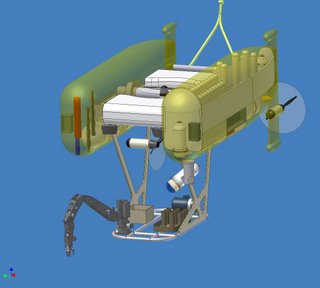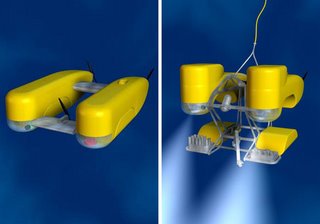Hybrid Remotely Operated Vehicle For Deep Sea Exploration
 The first humans to venture into deep sea exploration were Jacques Piccard and Don Walsh in 1960.They were the first humans to touch the bottom of Challenger Deep, a underwater trench with a depth of 10924m. After that no one, man or machine has scaled such depths.Researchers at the Deep Submergence Laboratory at Woods Hole Oceanographic Institution and Johns Hopkins University have been developing a vehicle called Hybrid Remotely Operated Vehicle(HROV) that will enable scientists to perform photography,biological sampling and topographical mapping of the world's deepest underwater trench, the Challenger Deep.
The first humans to venture into deep sea exploration were Jacques Piccard and Don Walsh in 1960.They were the first humans to touch the bottom of Challenger Deep, a underwater trench with a depth of 10924m. After that no one, man or machine has scaled such depths.Researchers at the Deep Submergence Laboratory at Woods Hole Oceanographic Institution and Johns Hopkins University have been developing a vehicle called Hybrid Remotely Operated Vehicle(HROV) that will enable scientists to perform photography,biological sampling and topographical mapping of the world's deepest underwater trench, the Challenger Deep. The Hybrid vehicle can either be controlled form the surface of the water by a controller or it can be programmed to do a variety of tasks autonomously.The HROV will be using a micro-cable that will enable the vehicle to go deeper without the drag of heavier cables. The HROV can also run for 36 hours on batteries only.
The Hybrid vehicle can either be controlled form the surface of the water by a controller or it can be programmed to do a variety of tasks autonomously.The HROV will be using a micro-cable that will enable the vehicle to go deeper without the drag of heavier cables. The HROV can also run for 36 hours on batteries only.
The HROV's first scientific mission is planned for 2008 and one of the first missions for the HROV is to obtain data from the Mariannas Trench that will enable scientists to learn more about the mantle how much the mantle is interacting with respect to the oceanic lithosphere.
 The HROV will be able to withstand pressure from 11000m of water with the help of a state of the art ceramic material. It is highly dangerous to send humans to such depths for fear of implosions.
The HROV will be able to withstand pressure from 11000m of water with the help of a state of the art ceramic material. It is highly dangerous to send humans to such depths for fear of implosions.
The HROV is a very advance robot and it will greatly help us understand the life and geography of the deep oceans.
References:
(1)http://news.bbc.co.uk/2/hi/science/nature/3373511.stm
(2)http://www.whoi.edu/sbl/liteSite.do?litesiteid=1810
Prakash S/O Yanaprakasam
U036229B